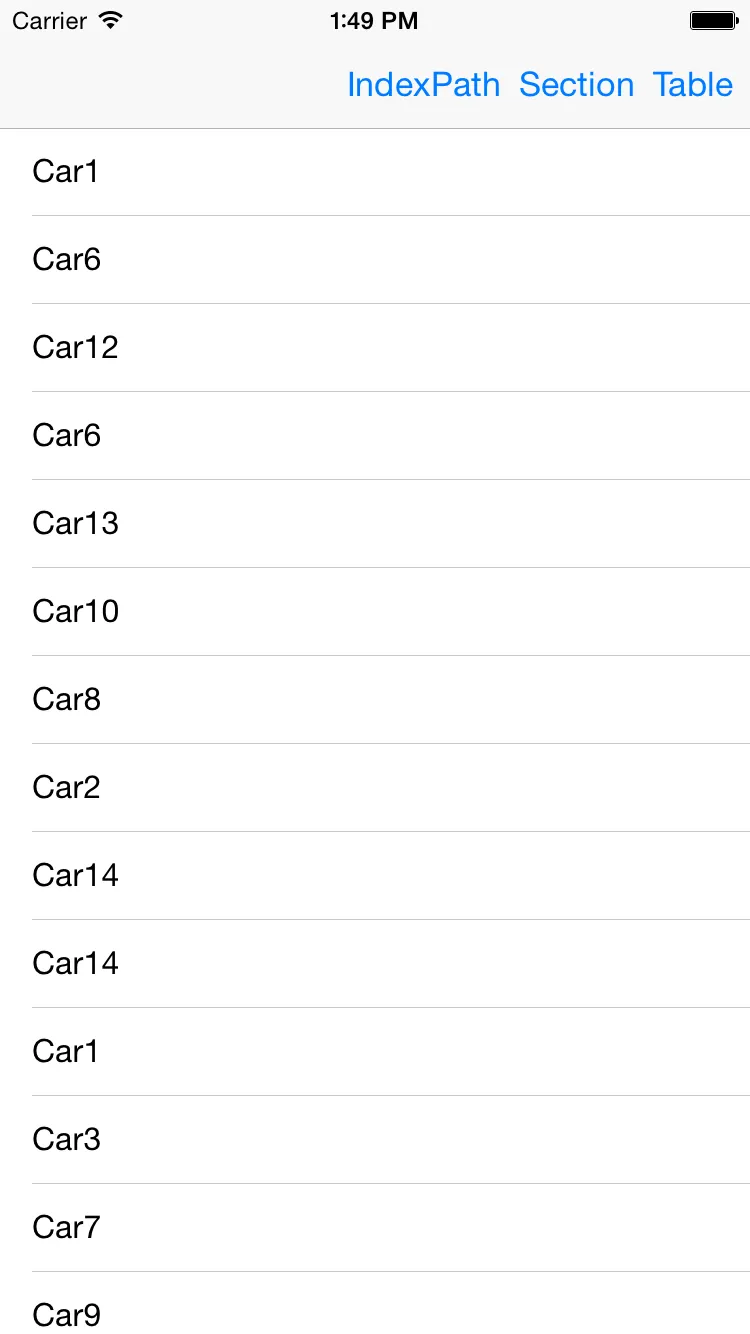我建立了一个测试应用程序,以测试重新加载表视图的这三种方法的性能。


//
// ViewController.m
// TableViewSample
//
// Created by Antonio081014 on 8/2/15.
// Copyright (c) 2015 Antonio081014.com. All rights reserved.
//
#import "ViewController.h"
@interface ViewController () <UITableViewDataSource, UITableViewDelegate>
@property (nonatomic, strong) NSArray *listOfCards;
@property (nonatomic, strong) NSIndexPath *selectedIndexPath;
@end
@implementation ViewController
- (void)viewDidLoad {
[super viewDidLoad];
// Do any additional setup after loading the view, typically from a nib.
NSMutableArray *list = [NSMutableArray array];
for (int i=0; i<15; i++) {
NSString *carName = [NSString stringWithFormat:@"Car%d", arc4random() % 15];
[list addObject:carName];
}
self.listOfCards = list;
self.tableView.delegate = self;
self.tableView.dataSource = self;
self.selectedIndexPath = nil;
UIBarButtonItem *table = [[UIBarButtonItem alloc] initWithTitle:@"Table" style:UIBarButtonItemStylePlain target:self action:@selector(reloadTable:)];
UIBarButtonItem *section = [[UIBarButtonItem alloc] initWithTitle:@"Section" style:UIBarButtonItemStylePlain target:self action:@selector(reloadSection:)];
UIBarButtonItem *indexPath = [[UIBarButtonItem alloc] initWithTitle:@"IndexPath" style:UIBarButtonItemStylePlain target:self action:@selector(reloadRow:)];
self.navigationItem.rightBarButtonItems = @[table, section, indexPath];
// self.navigationController.navigationItem.rightBarButtonItems = @[table, section, indexPath];
}
- (void)reloadTable:(UIBarButtonItem *)barItem
{
[self.tableView reloadData];
}
- (void)reloadRow:(UIBarButtonItem *)barItem
{
[self reloadRowAtIndexPath:self.selectedIndexPath forBarButtonItem:barItem];
}
- (void)reloadSection:(UIBarButtonItem *)barItem
{
[self reloadSectionAt:0 forBarButtonItem:barItem];
}
- (void)reloadRowAtIndexPath:(NSIndexPath *)indexPath forBarButtonItem:(UIBarButtonItem *)barItem
{
if (indexPath) {
[self.tableView reloadRowsAtIndexPaths:@[indexPath] withRowAnimation:UITableViewRowAnimationAutomatic];
}
}
- (void)reloadSectionAt:(NSUInteger)section forBarButtonItem:(UIBarButtonItem *)barItem
{
[self.tableView reloadSections:[[NSIndexSet alloc] initWithIndex:section] withRowAnimation:UITableViewRowAnimationAutomatic];
}
- (NSInteger)numberOfSectionsInTableView:(UITableView *)tableView
{
NSLog(@"Asking Number of Sections in TableView");
return 1;
}
- (NSInteger)tableView:(UITableView *)tableView numberOfRowsInSection:(NSInteger)section
{
NSLog(@"Asking Number of Rows in Section");
return self.listOfCards.count;
}
- (UITableViewCell *)tableView:(UITableView *)tableView cellForRowAtIndexPath:(NSIndexPath *)indexPath
{
UITableViewCell *cell = [tableView dequeueReusableCellWithIdentifier:@"Cell" forIndexPath:indexPath];
NSString *carName = self.listOfCards[indexPath.row];
cell.textLabel.text = carName;
return cell;
}
- (void)tableView:(UITableView *)tableView didSelectRowAtIndexPath:(NSIndexPath *)indexPath
{
self.selectedIndexPath = indexPath;
NSLog(@"Did Select Cell %@", indexPath);
}
- (void)tableView:(UITableView *)tableView didDeselectRowAtIndexPath:(NSIndexPath *)indexPath
{
self.selectedIndexPath = nil;
NSLog(@"Did Deselect Cell %@", indexPath);
}
- (void)tableView:(UITableView *)tableView willDisplayCell:(UITableViewCell *)cell forRowAtIndexPath:(NSIndexPath *)indexPath
{
NSLog(@"Will Display Cell %@", indexPath);
}
- (void)tableView:(UITableView *)tableView didEndDisplayingCell:(UITableViewCell *)cell forRowAtIndexPath:(NSIndexPath *)indexPath
{
NSLog(@"Did End Display Cell %@", indexPath);
}
- (void)tableView:(UITableView *)tableView didHighlightRowAtIndexPath:(NSIndexPath *)indexPath
{
NSLog(@"Did Highlight Cell %@", indexPath);
}
@end
当三个方法被调用时记录日志。
ReloadData
2015-08-03 11:00:51.556 TableViewSample[324:90811] 显示的单元格已结束 {长度=2,路径=0-11}
2015-08-03 11:00:51.558 TableViewSample[324:90811] 显示的单元格已结束 {长度=2,路径=0-10}
2015-08-03 11:00:51.559 TableViewSample[324:90811] 显示的单元格已结束 {长度=2,路径=0-9}
2015-08-03 11:00:51.560 TableViewSample[324:90811] 显示的单元格已结束 {长度=2,路径=0-8}
2015-08-03 11:00:51.560 TableViewSample[324:90811] 显示的单元格已结束 {长度=2,路径=0-7}
2015-08-03 11:00:51.560 TableViewSample[324:90811] 显示的单元格已结束 {长度=2,路径=0-6}
2015-08-03 11:00:51.561 TableViewSample[324:90811] 显示的单元格已结束 {长度=2,路径=0-5}
2015-08-03 11:00:51.561 TableViewSample[324:90811] 显示的单元格已结束 {长度=2,路径=0-4}
2015-08-03 11:00:51.562 TableViewSample[324:90811] 显示的单元格已结束 {长度=2,路径=0-3}
2015-08-03 11:00:51.563 TableViewSample[324:90811] 显示的单元格已结束 {长度=2,路径=0-2}
2015-08-03 11:00:51.563 TableViewSample[324:90811] 显示的单元格已结束 {长度=2,路径=0-1}
2015-08-03 11:00:51.564 TableViewSample[324:90811] 显示的单元格已结束 {长度=2,路径=0-0}
2015-08-03 11:00:51.564 TableViewSample[324:90811] 请求TableView中的部分数目
2015-08-03 11:00:51.565 TableViewSample[324:90811] 请求部分中的行数
2015-08-03 11:00:51.566 TableViewSample[324:90811] 将显示单元格 {长度=2,路径=0-0}
2015-08-03 11:00:51.567 TableViewSample[324:90811] 将显示单元格 {长度=2,路径=0-1}
2015-08-03 11:00:51.567 TableViewSample[324:90811] 将显示单元格 {长度=2,路径=0-2}
2015-08-03 11:00:51.568 TableViewSample[324:90811] 将显示单元格 {长度=2,路径=0-3}
2015-08-03 11:00:51.569 TableViewSample[324:90811] 将显示单元格 {长度=2,路径=0-4}
2015-08-03 11:00:51.569 TableViewSample[324:90811] 将显示单元格 {长度=2,路径=0-5}
2015-08-03 11:00:51.570 TableViewSample[324:90811] 将显示单元格 {长度=2,路径=0-6}
2015-08-03 11:00:51.571 TableViewSample[324:90811] 将显示单元格 {长度=2,路径=0-7}
2015-08-03 11:00:51.572 TableViewSample[324:90811] 将显示单元格 {长度=2,路径=0-8}
2015-08-03 11:00:51.573 TableViewSample[324:90811] 将显示单元格 {长度=2,路径=0-9}
2015-08-03 11:00:51.573 TableViewSample[324:90811] 将显示单元格 {长度=2,路径=0-10}
2015-08-03 11:00:51.
因此,从日志中可以看出:
[UITableView reloadData]消耗了16毫秒。
[UITableView reloadSections:withRowAnimation:]消耗了323毫秒。
[UITableView reloadRowsAtIndexPaths:withRowAnimation:]消耗了302毫秒。
问题:
- 即使只有一个section,为什么[UITableView reloadData]比重新加载sections更有效率?
- 为什么重新加载行需要那么长时间,实际上是什么导致了这个时间?
- 有哪些工具可以帮助我验证或调试类似的问题?是否有任何帮助链接参考?
- 谢谢。
reloadData没有任何动画,不像reloadSections:withRowAnimation和reloadRowsAtIndexPaths:withRowAnimation,它们在重新加载tableView的行/单元格之前验证您的动画,这也适用于collectionView。 - 0yeoj